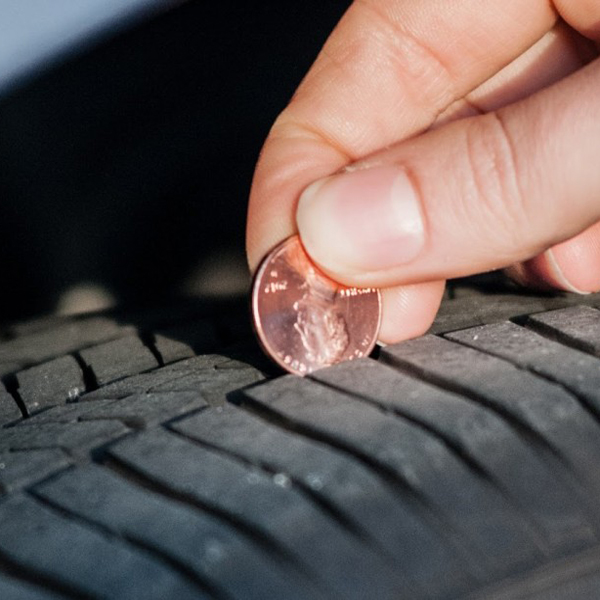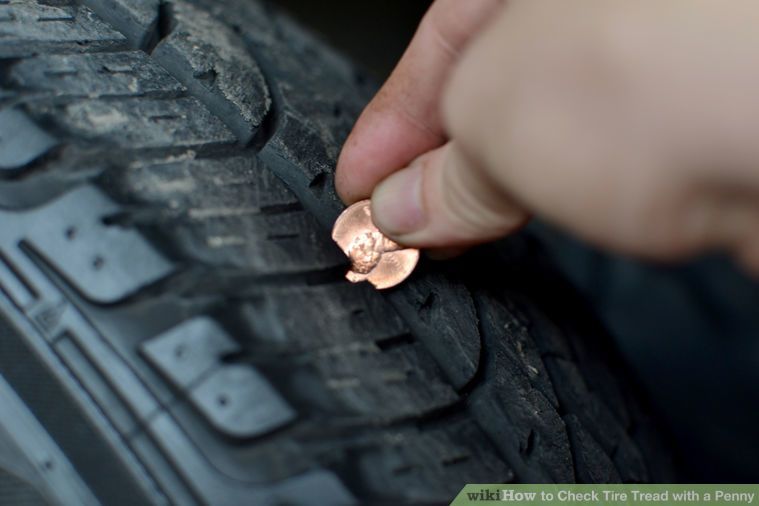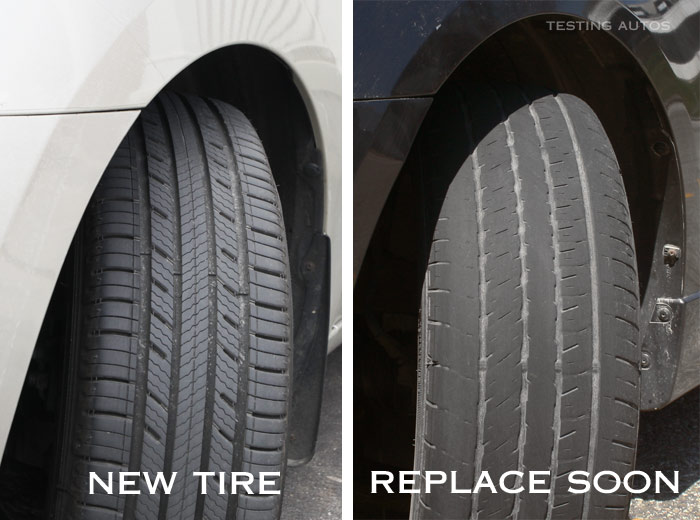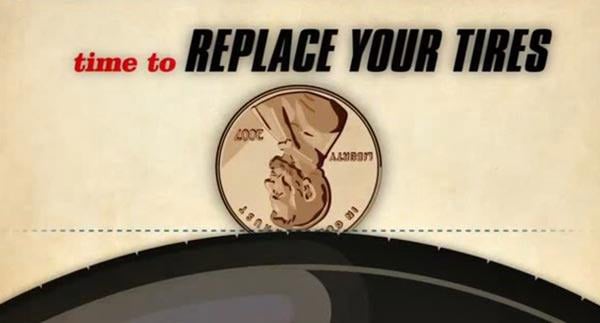When it comes to checking tire tread, there are a number of methods that can help you know if it’s time to replace a tire. Heavily worn tread will prevent a tire from performing as designed and can lead to unsafe driving conditions. One of the simplest, most common ways to check tread depth requires nothing more than a penny and a few moments of your time.
In the United States, tire tread depth is measured in 32nds of an inch. New tires typically come with 10/32” or 11/32” tread depths, and some truck, SUV and winter tires may have deeper tread depths than other models. The U.S. Department of Transportation recommends replacing tires when they reach 2/32”, and many states legally require tires to be replaced at this depth.
The idea of the penny test is to check whether you’ve hit the 2/32” threshold. Here’s how it works:
Place a penny between the tread ribs on your tire. A “rib” refers to the raised portion of tread that spans the circumference of your tire. Tire tread is composed of several ribs.
Turn the penny so that Lincoln’s head points down into the tread.
See if the top of his head disappears between the ribs. If it does, your tread is still above 2/32” , If you can see his entire head, it may be time to replace the tire because your tread is no longer deep enough.
When performing the penny tire test, remember not only to check each tire, but to check various places around each tire. Pay special attention to areas that look the most worn. Even if parts of your tread are deeper than 2/32”, you should still replace the tire when any areas fail the penny test.
Consistent wear around the whole tire is normal, but uneven tread wear could be a sign of improper inflation, wheel misalignment, or a variety of other things. If you see uneven tread wear, you should have a technician inspect your vehicle.
A simple way to check your tire tread depth is by using a tread depth gauge. You can find tire tread depth gauges at your local auto parts store. There are many models available, but an inexpensive simple graduated probe gauge will work just fine. All you have to do is stick the probe into a groove in the tread and press the shoulders of the probe flat against the tread block and read the result. All gauges should measure in both 32nds of an inch and millimeters.
You can find tire tread depth gauges at your local auto parts store. There are many models available, but an inexpensive simple graduated probe gauge will work just fine. All you have to do is stick the probe into a groove in the tread and press the shoulders of the probe flat against the tread block and read the result. All gauges should measure in both 32nds of an inch and millimeters.
Another indicator of worn out tread already lives in your tires themselves. Every performance, light truck, or medium commercial tire comes equipped with indicator bars (or wear bars) embedded between the tread ribs at 2/32”. They’re there to help you monitor tread depth and make decisions about tire replacement. Just look to see if the tread is flush with the indicator bars. If they are, it’s time to replace the tire.
While the penny tire test does deliver on what it promises – indicating whether tread has reached the legal limit – it may not be the best indicator of whether your tires are safe for the road. Tire performance can diminish significantly before your tread hits 2/32”. Even though the law deems fit for safe driving may not prevent you from hydroplaning or losing control in rainy, slushy conditions. If you think your tires may be close to needing replacement, have them checked out by a licensed mechanic.
Tire performance can diminish significantly before your tread hits 2/32”. Even though the law deems fit for safe driving may not prevent you from hydroplaning or losing control in rainy, slushy conditions. If you think your tires may be close to needing replacement, have them checked out by a licensed mechanic.
Calculate Out-The-Door Price
close
With this easy test, a penny can buy you peace of mind when it comes to your tires and safety.
Place a penny head first into several tread grooves across the tire. If you always see the top of Lincoln’s head, your treads are shallow and worn. If this is the case, your tires need to be replaced.
If part of Lincoln’s head is always covered by the tread, you have more than 2/32 of an inch of tread depth remaining. This means you probably don’t need new tires.
When your tire treads are worn, your car may respond poorly in adverse weather conditions like rain and snow. With good treads, your car will grip the road better. Also, having insufficient tread is considered illegal in many states. And finally, worn treads can make other parts of your car wear prematurely.
Potential Problem Areas:
When it’s time to change your tires, your Firestone Complete Auto Care dealer wants to make purchasing a new set as simple as possible. We have the best selection of quality tires to fit your vehicle, your budget and your driving style. From economy to ultra high performance tires - in the size you need from brands you trust, including our well-known Bridgestone and Firestone brands - you can find what you need right here.
We have the best selection of quality tires to fit your vehicle, your budget and your driving style. From economy to ultra high performance tires - in the size you need from brands you trust, including our well-known Bridgestone and Firestone brands - you can find what you need right here.
Make a selection from the following options:
Shop for Tires
Find a Store Near You
Schedule an Appointment
{{storeNumber}}
{{storeName}}
{{link-icon "Call Us" mobileCallLink null "call-cta"}} {{link-icon "Directions" directions "_blank" "directions-cta"}}
{{address}}
{{city}}, {{state}} {{zip}}
{{#if activeFlag}} {{#ifCond mystore "or" myPreferredStore}} {{#ifCond storeType 'eq' "TPL"}}
*Call store for appointment {{phone}}
{{else}} {{#if onlineAppointmentActiveFlag }}
{{#if myPreferredStore}}
{{else}}
*Call store for appointment {{phone}}
{{/if}} {{/ifCond}} {{else}} {{#ifCond storeType 'eq' "TPL"}}
*Call store for appointment {{phone}}
{{else}}
Schedule Appointment {{#if onlineAppointmentActiveFlag}} {{else}}
*Call store for appointment {{phone}}
{{/if}}
{{/ifCond}} {{/ifCond}} {{else}}
*Temporarily Closed Due To: {{temporarilyClosedReason}}
{{/if}} {{#if isMilitaryStore}}
*This location is on an active US military base. You may need military ID to access the location.
You may need military ID to access the location.
{{/if}}
Tires are one of the most important parts of your car, but changing tires can sometimes take you by surprise. There's nothing like a flat tire on the side of the road to make you realize you haven't really looked at your tires lately - and maybe you should.
Here are 5 signs your tires are worn out and need to be replaced. nine0009
The Penny Test is the easiest way to check your tire tread and people have been using it for generations. To make sure your tires have enough tread to provide enough traction while you're driving, simply take a penny and place it head down in the tire tread. If you can see Lincoln's entire head, you're missing a protector.
Since tires may wear unevenly, it is recommended that you perform a penny test at several points on each tire. It's also a good idea to change your tires every few months so that the front tires don't wear out before the rears, or vice versa.
Most tire problems are best diagnosed when your car is not moving, but it's also a good idea to pay attention to it while driving. If your car vibrates a lot while driving, this may indicate a tire problem. Of course, vibrations can be caused by poor alignment or bumps that need to be replaced, but no matter what, a lot of vibration while driving is no good and you should check it out. nine0009
If you're wondering how to tell if your car is vibrating more than usual, try turning off everything in your car: radio, heater, air conditioner, and anything else that makes noise. Then go on a paved road without bumps and see how your car behaves. If it's a bumpy ride, you might want to go to a mechanic.
If it's a bumpy ride, you might want to go to a mechanic.
Tires can be damaged unexpectedly and often people may not realize they have damaged tires until they stop working. If you don't like dealing with unexpected flat or burst tires, it's a good idea to have your tires checked monthly to see how they feel. nine0009
When checking tires, look for anything unusual such as cracks, dents or bulges. These are all warning signs that your tires need to be replaced.
Checking tire pressure is actually more of a preventive measure for tire health. Driving with under-inflated tires can cause more tire wear. You should check your tire pressure every month or so, before big trips and whenever the weather changes, as temperatures can affect tire inflation. nine0009
Regular tire pressure checks can also alert you to a slow leak problem. If one tire is consistently low in pressure, you may need to get it fixed or get a new tire.
If one tire is consistently low in pressure, you may need to get it fixed or get a new tire.
Sometimes tires just get old. Obviously tires wear faster or slower depending on how much you ride and how well you take care of your tires. However, most tire manufacturers recommend replacing your tires every 6-10 years. Always check with a specific tire manufacturer to see what they recommend. nine0009
Keeping your tires in top condition can help protect your rims and keep your vehicle running efficiently. That being said, new tires can also be expensive depending on the type of tires you have, the type of vehicle you drive, and where you choose to buy new tires. That's why it's important to consider the optimal time to buy new tires. Here's our expert guide on how often you need new tires. nine0009
If you prefer to work with a general tire life history guide, Edmunds suggests that you should change tires every six to ten years. However, there are a number of factors that can contribute to the well being of your tires. This may include your driving habits, frequency of travel, type of tires you have, road conditions in your area, and more. This means that your tires may need to be replaced more or less than average. Fortunately, there are more tangible signs that it's time to change your tires, including damaged tires, worn tread, and vehicle turbulence. nine0009
However, there are a number of factors that can contribute to the well being of your tires. This may include your driving habits, frequency of travel, type of tires you have, road conditions in your area, and more. This means that your tires may need to be replaced more or less than average. Fortunately, there are more tangible signs that it's time to change your tires, including damaged tires, worn tread, and vehicle turbulence. nine0009
It is obvious that you need to buy new tires when you have damaged your old tires. Tire damage can be physically obvious, so it's important to inspect your tires regularly for any abnormalities. Look for punctures, scratches, scuffs, and anything else that might look out of place on your tires.
Tire damage can also affect the performance of your vehicle. If you feel like your car is using more gas than you're used to, take your car to a professional for a tire inspection. Damaged tires can release air, making your car run harder and use more gas. While you can temporarily patch holes or other problems, a damaged tire is the first and most important indicator that it may be time to consider new tires for your vehicle. nine0009
While you can temporarily patch holes or other problems, a damaged tire is the first and most important indicator that it may be time to consider new tires for your vehicle. nine0009
The tread on your tires helps you control the road and keeps your vehicle safe. This creates the resistance your tires need to stop when braking. Over time, the tread begins to wear down, making your tires more slippery on the road and reducing the traction you need to start and stop your car comfortably. When your tread wears out, you need new tires. nine0009
There is a penny test to check if you have enough tread on your tires. To do this, insert a coin with the Lincoln head down into the tire tread. If you can see the top of the Lincoln's head, it means your tire's tread has worn down considerably. Typically, when you start to see the top of your Lincoln, it's time to change your tires.
If your vehicle shakes or vibrates while driving, this often indicates a tire problem. You may need your tires balanced to restore your car to perfect function, but more serious problems may require a tire replacement. Consult a tire specialist to find out if your vehicle's shaking can be corrected with tire balancing or if a tire needs to be replaced. This problem may also be related to only one of your tires, which a specialist can also help you identify and repair. nine0009
You may need your tires balanced to restore your car to perfect function, but more serious problems may require a tire replacement. Consult a tire specialist to find out if your vehicle's shaking can be corrected with tire balancing or if a tire needs to be replaced. This problem may also be related to only one of your tires, which a specialist can also help you identify and repair. nine0009
Chapel Hill Tire is a one stop tire shop in North Carolina. With all the knowledge, tools and car maintenance you need, Chapel Hill Tire is ready to serve your tire needs. We offer popular tire brands such as:
When you buy new tires, you want to make sure you get a good price.